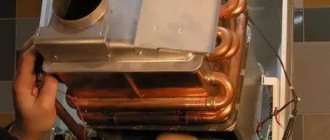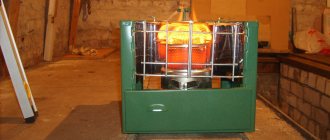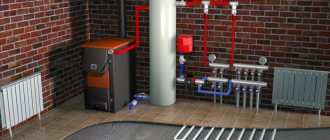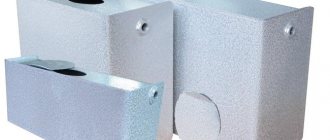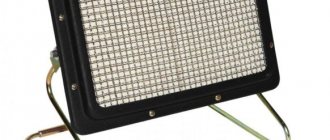Many garage owners use them not only as a haven for cars, but also as work workshops.
And working in a cold room in the mid-season and winter is not a pleasant pleasure. Therefore, car enthusiasts solve the problem of organizing heating as best they can. Today, the main ways to heat a garage are:
- use of electric heaters;
- installation of a stove-stove;
- the use of heaters operating on sawdust and fuel vapors;
- organization of a water-type system.
All of the above methods are justified when organizing garage heating. But the first three are flammable, and if you take into account that there are always a lot of flammable substances in the garage, they must be used with extreme caution. The latter is good, but quite difficult to install; not every garage owner will be able to independently create an effective water heating system.
Not long ago, a new way of organizing heating appeared - installing heaters that emit infrared heat.
These devices gained popularity in a very short time. Why? This is what we'll talk about.
Operating principle of infrared heaters
The operation of such heating devices is based on the generation of heat due to long-wave infrared radiation, which most naturally reproduces the effect of sunlight. The bottom line is that infrared heaters heat the surfaces of objects, and not the air, which then heats things up. Such heating is very effective and comfortable for a person, since it is closest to his physiology.
IR heaters can be used effectively in any room and even outdoors, creating a localized heat transfer zone in the required location.
These heating devices are very economical, which is explained by the absence of losses of generated thermal energy. It is not spent on heating the surrounding air space. The air is gradually warmed up by secondary heat given off by heated surfaces.
The use of infrared heaters brings about 40% savings in energy consumption compared to other types of heating devices. To calculate the required power of IR heaters for a specific room, it is enough to take into account that 1 m³ of volume requires 25...100 W of power. Typically, about 50 W/m³ is taken into account for a garage.
Infrared heaters operate from the mains. Unlike other heater models, they can be placed on the ceiling, which will avoid taking up useful space on the walls and floor of the garage.
All types
We consider the concept of “warm floor” in the broadest context - both as a heating system using a water circuit or flexible electrical conductors, and as insulation of the lower part of the floor with a reliable heat insulator.
Expanded clay and other bulk options
The most common option that does not require a lot of money and effort. However, the return on it is minimal.
Best suited if you form the flooring yourself. It is easy to work with such bulk insulation:
There are other bulk heat insulators - perlite, vermiculite. If you use them, then a layer of 10-15 cm is enough.
Expanded polystyrene boards
A warm floor in a garage can also be installed using polystyrene foam boards. The fragments are connected to each other with a lock and eliminate any cracks or gaps. And if the size doesn’t fit, you can always use a regular knife to correct it.
The technology for laying such a floor is practically no different from bulk options. But its efficiency is higher, so it’s worth taking note.
Water heating
A full-fledged heated floor in the literal sense of the word. It is a complex arrangement of pipes connected to a heat source located in the room. If your garage is adjacent to the house and connected to a centralized heating system, then this greatly simplifies the matter - in this case, the coolant is connected to it.
But most often the opposite is observed - in this case, an autonomous boiler (gas, stove, electric) acts as a heat source.
How it works
It's simple: the water warms up the pipes, and the heat from them is transferred to the entire floor covering and slowly rises into the air.
Advantages:
Flaws:
Electric
The heated floor option that is most often chosen for the garage. Largely due to the ease of installation.
How it works
There is nothing complicated here either: the heating circuit with an electric cable is mounted on a flexible mat that is laid into the floor. Connected through the outputs to the central unit, the conductor heats up and, as in the case of water heating, transfers heat to the screed and the entire floor.
Advantages:
Flaws:
Benefits of infrared garage heating
Let's consider all the advantages of infrared heating of the garage:
Variability and ease of installation
Manufacturers offer different types of infrared heating devices: heaters, films, panels. With the help of these inventions you can heat your entire garage very economically. Films, for example, are perfect for covering ceilings, walls, pits and basements.
In addition, they can be covered with a decorative coating. Radiant heat will still flow indoors, warming up the surfaces of the garage. In addition, a thermostat unit can be connected to the infrared heating system, allowing automatic adjustment and effective control.
Each garage owner can choose the best option for their own premises. But while IR heaters still take up little space and sometimes require dusting off, films and panels require absolutely no maintenance and are easily installed and connected by the garage owner.
Economical
IR heaters use electrical energy sparingly and heat more efficiently than other types of heating devices. In addition, you can save money by organizing heating of only the necessary areas, for example, a rack with tools, a workbench, etc.
Resistance to dampness
When the heaters are placed on the ceiling, an analogue of heating by the sun's rays is recreated, which prevents the formation of mold and fungi. This property of infrared heaters is especially valuable for damp garages.
Disadvantages of infrared garage heating
Summarizing the feasibility of using infrared heating devices in garages, it is worth noting their disadvantages:
- the novelty of heaters and the still insufficient awareness of their properties, installation and use features require care when choosing them and creating a heating system;
- quite high cost;
- electricity costs.
But, despite this short list of disadvantages, IR heaters are by far the most harmless and environmentally friendly. And their long service life (minimum 25 years) makes them ideal for use in garage heating.
Infrared ceiling heaters FlexiHIT
The ease of installation and use of an infrared (IR) heater is only an addition to its main beneficial properties: safety, hygiene and energy efficiency.
Converting electricity directly into heat, the lightweight and compact device is installed no more complicated than a lamp.
Components of the efficiency of an IR heater:
- no idle operation - for heating the under-ceiling space;
- durability (20–30 years);
- thermal effect immediately after turning on the device (heat transfer by EM waves occurs at the speed of light);
- reduction of heat loss during ventilation;
- low power consumption.
During operation, the heater does not dry out the air, does not emit harmful substances, is silent and does not create air currents. The safety of this type of heating is evidenced by the widespread use of infrared heaters in children's institutions, sports complexes, and hospitals.
The disadvantage of an electric infrared heater is its dependence on power supply. And its simple dismantling and low weight (3–5 kg) are beneficial to the hunter of other people’s property.
Types of devices
The type of heating particles installed inside the device is of great importance. At the moment, three options are popular: carbon, ceramic and halogen.
- Ceramic. A good option, since the device does not produce a glow and works only on medium and long waves, without generating dangerous short ones.
- Halogen. They are used less and less because they emit bright light during operation, which is irritating to the eyes. In addition, the heater in halogen models is a source of short-wave infrared radiation.
- Carbon. They glow only a little red, which sometimes has a negative effect on people with allergies and asthma. Much less harmful than halogen ones, but more harmful than ceramic models.
You should pay attention to the thermal insulation of the heating element, which prevents the body from heating and melting. Any chemical additives can release toxic substances when heated for a long time
The optimal insulation option for such IR devices is considered to be basalt, preferably free of impurities.
Separately, it should be noted that recently appeared film IR heaters. With their help you can quickly heat a large area, floor and walls. The generated heat and waves do not harm health and are absorbed by a person for benefit to the body. The maximum heating temperature of film models is about 50 degrees - enough for domestic use.
Operating principle
An infrared heater for a garage is chosen to solve various problems:
- quickly create thermal comfort for performing work;
- locally raise the temperature in a given zone (on a workbench, near a wheel, above the hood);
- control the growth of humidity in the garage;
- maintain a positive temperature near the machine (+5 °C is enough for easy engine starting).
Heating occurs due to the transfer of radiant energy from the heating device to less heated surfaces. The mediator is infrared radiation. Air retains only a few percent of heat (the more, the higher the dust and CO2 content in it).
The space is heated already from objects, which helps to reduce heat loss through the enclosing structures, because They are often poorly insulated.
Infrared radiation travels in a straight line. This is worth remembering when choosing the location of the device for local heating.
In the garage, household heating devices of long-wave infrared radiation, electric and gas, are used.
Three ways to transfer heat
In eighth grade physics lessons, teachers taught that there are three types of heat transfer:
- Thermal conductivity is the transfer of heat from less heated bodies to more heated ones. To carry out the process, contact between bodies is necessary. The object on top of the radiator will heat up due to thermal conductivity.
- Convection is a process in which heat is transferred by flows of liquid or gas. All classical heating systems are based on this effect. Hot air rises, cold air falls down. Therefore, all heating radiators must be located below, near the floor.
- Radiation (radiant heat transfer) – heat is transferred using waves. The infrared radiation discussed above refers to this method of heat transfer.
Electric infrared heaters for garages
A household IR heater with a closed electric heater is suitable for residential and commercial premises. (“Open” models are more powerful and require a significant distance from objects).
The power of such electrical appliances is 0.5–1.5 kW, the current is 2.5–6.5 A, power supply is 220 V. The operating area of a household heater is 3–15 m2 in winter, in the off-season - 12–30 m2.
The minimum permissible height of its suspension depends on the power of the heater.
For a ceiling height of 2.5–3 m, use an infrared heater no more powerful than 1 kW. Starting a car engine in winter will be facilitated by a 1 kW emitter installed above the hood on the ceiling of an insulated garage with an area of 20 m2. To heat the work area, a heater is installed above it.
Full heating of such a garage up to +20 °C will be provided by two devices of the same power. The design of the infrared closed electric heating device is simple.
The low-temperature tubular electric heater is covered on the front side with a metal plate, and on the back side with a heat-insulating liner. The input box is fixed to the heat insulator. The metal case is equipped with brackets for hanging.
Installation of water heated floor
If you have a garage adjacent to the house, it is worth installing a water floor - a budget option, since the connection is permissible to the heating system of the house. If this is not possible, you will have to install an autonomous boiler.
Warm. garage floor. With your own hands. With an inspection hole. As we did for ourselves... Reliably.
Development of laying scheme and calculations
The fundamental factor in the calculation is the pipeline laying scheme. More often, pipes are laid in a “snake” or “snail” pattern.
An important indicator is the laying step and the size of the contour. In order for the garage to warm up well, the distance between the turns should be 10 cm.
And also, it is necessary to correctly determine the installation location of the distribution unit.
When making your own calculations, it is recommended to use average indicators:
- cross-section of metal-plastic pipes - 16 mm;
- loop size, if the area is 60 m2 - from 70 to 80 meters;
- pump power - not less than 2 l/s.
Pipes should be laid more often near walls and gates than in the center of the room. The supply hose is located near the outer walls.
Tools and materials
To install a water floor in a garage with your own hands, you can buy a standard type kit with an automatic regulator, which is produced for non-residential premises measuring 60 - 80 m2, or separately components.
The average amount of material required for a hydrofloor in a garage of a given area, with a pipe pitch of 15 - 20 cm and a screed of 7 cm:
- metal-plastic pipes - 400 meters;
- plasticizer - 80 liters;
- damper tape - 60 meters;
- insulation - 60 m2;
- three-way valve - 1 piece;
- circulation pump - 1 piece;
- thermostat - 1 piece;
- plastic fittings;
- automatic air vent—2 pcs.;
- servomotor—1 pc.
You will also need a standard set of tools for working with metal-plastic pipes, a set of screwdrivers, a tape measure, wire cutters and a mixer for preparing the solution.
Preparing the base
The heated water floor in the garage is mounted on a rough leveling screed. It is poured onto a “pie” of:
- sand - 10 cm;
- crushed stone - 10 cm;
- insulation - polystyrene foam 10 cm;
- waterproofing - polyethylene or roofing felt;
- fittings.
If you have a concrete floor, it is enough to remove the top layer, clean and level the surface. The differences in the garage should not exceed half the diameter of the pipe.
Hydro and thermal insulation
The work on insulating the hydrofloor is the same as when installing an electrical structure. A layer of waterproofing is laid on the rough base - thick polyethylene, but roofing felt is better for a garage; the seams are coated with bitumen mastic.
Then comes the insulation, the material must be thick, as it will experience a large load. To prevent heat from escaping into the floor, the foil side is directed upward.
It is mandatory to apply damper tape around the perimeter of the room.
Pipeline laying
On the thermal insulation, according to the diagram, markings are made for installing pipes. Plastic supports are installed, and sheathing is mounted on them. The grid should be placed above the insulation at a distance of 3 - 4 cm - this will help avoid cracking of the concrete.
The heating element is placed on the fittings, following the markings made. The pipes are secured with brackets or clamps, which are installed every 30 - 40 cm, at turns - 15 cm.
Coils with pipelines need to be unwound gradually, 10 - 15 meters apart. Laying pipes should begin from the collector, from the loop farthest from it. A heat-insulating tube with a fitting is placed on the end of the hose; it is needed to connect the hose to the manifold. The second end of the pipeline, after laying throughout the entire garage area, should also return to the distribution center.
Collector-mixing unit
The mixing unit is the “heart” of a warm water floor. It is designed to regulate and supply hot water to the pipeline, as well as to remove waste coolant from the system.
You can assemble the device yourself, or you can purchase a ready-made one, its cost is reasonable. In a collector, the level of thermal load plays an important role.
The collector consists of:
- supply and drain valve;
- air vent;
- shut-off valve for draining water from the system;
- fittings for connecting pipes;
- circulation pump.
You must select a collector-mixing unit based on the number of circuits; the device must have an output for each.
The collector is installed in the garage, in a specially equipped cabinet. Its standard size is 50 by 50 cm, with a depth of 15 cm. It can be placed on the wall or in an equipped niche.
The mixing unit is connected to the coolant supply source, this can be the main heating system or boiler. Water circulation is carried out by a pump.
After installing the unit, it is necessary to connect both ends of the pipe of each circuit to the supply and return valves with fittings.
Before pouring the screed, you should check the system for leaks. To do this, a coolant liquid is supplied into the main line at a pressure 2 times higher than the working one. If the pressure does not drop within 24 hours, then the structure is installed correctly.
Filling the screed
The concrete screed must be poured at the operating pressure in the system, and the temperature of the pipes must correspond to the temperature in the garage. The thickness of the concrete layer is from 5 to 12 cm.
Filling starts from the far corner of the garage and ends at the gate. The system can only be turned on when the concrete is completely dry, after a month.
Options for placing infrared heaters
Options for placing the IR heater: on the ceiling; on the wall (oblique); on a portable stand.
An IR heater in the form of a panel for a false ceiling (60×60×3 cm, current up to 2 A) is also used as a wall or ceiling heater.
In a garage, a ceiling unit is most convenient. Wall placement significantly reduces efficiency: a significant portion of the radiant heat is absorbed by the walls.
Advantages of ceiling mounting of an IR emitter:
- saving space;
- avoiding accidental contact with him;
- distance from flammable substances;
- maximum heat coverage of objects and people.
Which company should you choose?
There is a large selection of equipment models and manufacturers on the market, including:
- RESANTA is a leader in the welding inverter market. The company presents a large selection of heating equipment: from household devices to devices that are in demand in production and warehouse facilities.
- Ballu is a company that provides climate control equipment. In its work technology, using environmentally friendly materials. Manufactured products meet not only Russian, but also international quality standards.
- Electrolux is a Swedish manufacturer of household and professional appliances. Heating equipment is manufactured using an inverter heating system, which saves energy.
- Solarogaz is a Russian manufacturer based in Penza. It has been manufacturing diesel and gas heaters for more than 20 years.
- Aeroheat is a manufacturer of heating equipment that creates modern products that meet not only quality standards, but also follow new trends (from a technical and design perspective). The company's equipment has wide functionality, advanced technical characteristics and guarantees a high level of comfort.
- Zanussi is an Italian company producing household and heating appliances. The price range of equipment is from economy to middle class. The company has been one of the world leaders in the production of household appliances since 1994.
- Polaris is a Swiss brand, developed by European engineers. Every year the company presents innovative solutions that expand the capabilities and functions of equipment. Polaris heaters are in great demand in many countries around the world.
Fire precautions
What is important to ensure when installing and using high-quality IR heaters in the garage:
- distance from flammable materials (the minimum distance depends on the power of the device);
- parallel connection of several IR heaters;
- no twisting of wires to connect them to the terminal (the wire cross-section is indicated in the instructions);
- extension of suspensions (up to a minimum of 10 cm) that remove the device from the ceiling or cable ducts made of easily melting materials (polystyrene, PVC).
Hygiene and injury safety
The location of the IR heater should prevent accidental contact with the emitting plate. Its temperature in low-power devices is about 80 °C.
Handprints on the emitting plate become clearly visible over time. Cotton gloves will protect you from touching the emitter with your palms when installing the infrared heater.
The first switching on of the device may be accompanied by the smell of technological lubricant. It will evaporate within a few hours of operation at maximum power. All that remains is to ventilate the garage.
To do or not to do?
On the one hand, you get the opportunity to always maintain a comfortable temperature in the garage even in the coldest period. In this case, the heat will be distributed evenly over the entire area of the room, which is impossible when using autonomous convectors.
However, there is a downside to everything: due to the temperature difference, frost will appear on the gate, and condensation will invariably appear inside the room. It also makes sense to use underfloor heating in your garage if you use it frequently. Periodic switching on will not give a noticeable result in warming up, and the potentially high efficiency of the system will remain unrealized.
And one more point, no less important: all installation work must be carried out in full compliance with the requirements of SanPin. Therefore, studying them carefully is your obligatory task.
Reviews on the use of an infrared heater for a garage
Alexey, Vyborg:
“It crackles for a few minutes after turning it on, the instructions say that this is normal. It immediately becomes comfortable in the garage.”
Veniamin, Pskov:
“The ICO is connected via a thermostat with a timer. In the morning it turns on itself, in the evening it remains to work for 2-3 hours. From the moment of installation, it does not require attention to itself.”
Anna, St. Petersburg:
“The emitter is above the exit from the underground garage. Quickly removes ice and snow on the ascent.”
The choice of heating through radiant heat exchange is justified in any room. In the garage, the dependence of an infrared electric heater on the uninterrupted supply of electric current is least distressing. Whereas the opportunity to warm a person, objects, a machine, and not a space, with a waste of time and money, can hardly be overestimated.
How to use the Master 450 CR gas infrared heater for the garage, watch the video:
Making a heated floor in the garage: 40 photo tips with prices
If you want your garage to always be comfortable, there is a reason to think about installing a heated floor in it. There are several options for its installation, and each of them is replete with a large number of pitfalls. But don’t be in a hurry to lose heart: all the nuances in this article will be safely brought to the surface, and useful tips will help you make the right choice. We talk about all types of heated floors in the garage, the advantages and disadvantages of each system, and also provide prices and technological algorithms for productive work.
No comments yet
Dedicated to those who are going to work in the garage in winter, but have not yet taken any measures to heat it, and do not know how to do it correctly. I hope it helps someone.
It's exactly -20 outside.
As you understand, it is impossible to fully work in a garage without heating. Well, then I will present options for electric heating of the garage that I have personally tested. I would like to say right away that in the conditions of the harsh Russian winter, you should not entertain the illusion that buying some kind of household heater for ridiculous money will give you the opportunity to feel comfortable in the garage when it is -15 or colder outside.
100% OPTION IS A WOOD STOVE, but due to lack of space for storing firewood and installing this stove, we omit this option.
Gas
In terms of the cost of energy (natural gas), this is the highest in the garage, but it is accompanied by hidden costs:
- preparation of design and permitting documentation;
- payment for the work of licensed gas equipment installation specialists;
- costs for ventilation and removal of combustion products;
- costs for routine maintenance of the boiler;
- possibly the necessary construction and subsequent maintenance of the chimney.
Alternatively, to heat the garage you can use infrared gas heaters, heating panels, convectors that consume liquefied propane and butane in cylinders - this eliminates the need to go through the authorities, but adds the problem of providing fuel.
Features of gas heating:
- advantages - high level of automation of the heating system, when using natural gas - constant availability of energy in the main line, cost-effectiveness and high efficiency of gas equipment;
- disadvantages - the presence of a danger factor of explosion, fire or carbon monoxide poisoning.
When using gas heating, the building owner must especially strictly observe safety requirements in his garage.
A good option for a garage is an automatic steam-drip condensing unit, which is up to 15% more economical than other models, as it can operate efficiently at low gas pressure. In the heat exchanger of such a boiler, water from heating with a gas burner turns into steam, and then condenses again into a liquid state, which is accompanied by the release of heat. Such boilers are produced in floor-mounted and wall-mounted versions. For a garage, the second option is preferable, eliminating the possibility of tipping over when performing some work.




